If you have a small vegetable garden, I am happy to tell you that there is still so much that you can grow! There are many crops that really don’t require much space and can be grown even in the tiniest garden. We’ll go over planting options to maximize your space and what kinds of vegetables you can plant in a small vegetable garden.
I remember a few years ago, when we lived in town and I only had a couple of raised garden beds, how determined I was to grow just about every vegetable there is in the tiny space.
I would order way too many seeds, plant everything way too close to each other, and attempt to grow a spring, summer, and fall garden.
If to be honest, it didn’t work.
Some seeds didn’t germinate, some seedlings died very young, most plants didn’t reach full size, and yields were very small. Of course, because I am so damn stubborn, I kept trying for a few seasons to make it work. But finally, I had to give up and really start paying attention to the plant spacing that is listed for every plant.
22 Crops to Grow in a Small Vegetable Garden…

I also realized that I can’t expect to grow it all. I had to choose a few crops and concentrate on them, the rest I had to buy at the market.
But..
What Should I Grow in a Small Vegetable Garden?
I had to decide what makes more sense. If I wanted to grow tomatoes, four plants will take one full bed, I wouldn’t be able to plant anything else in this bed because I’ll need to plant the tomatoes in April and they will stop producing at the end of September (here is how and when to pick tomatoes).
If I planted a spring garden in that bed, the bed won’t be available for tomatoes in the middle of April, and I won’t be able to plant a fall garden there because the end of September is too late for fall/winter planting. We will enjoy about three months (July, August, September) of fresh, homegrown tomatoes.
However, If I grew loose lettuce, green onions, and carrots in the same bed, we will be eating from the garden in the middle of April, all through the summer, and I’ll be able to plant a fall garden as well.
This made more sense, even though I really like homegrown tomatoes.
I also took into consideration the price of vegetables in the market. For example, cabbage is very cheap to buy but hard to grow. It takes a lot of space, here in NC cabbage has so many pests, it takes a long time to mature (if it ever gets there), and I will have to start seeds indoors or buy transplants.
So obviously, cabbage wasn’t a good crop for my small garden.
Lastly, I looked for crops that I can space very close to each other. In the space of one broccoli, I could plant 100 carrots, in the space of one pumpkin, I could plant 200 seeds of spinach, in the space of one zucchini, I could plant 400 seeds of loose lettuce mix. Those are not exact numbers, but I hope you get my point.
So now that I had a better direction, it was time to make the list. I was looking for crops that I can space 4” apart or less, that we eat on a regular basis, and that will be pricey to buy at the market.
Two Ways to Plant a Small Garden…
Before we go down the list of vegetables to plant in a small garden, let me go over two ways of planting:
- One row – When planting in one row, you simply dig a furrow, and place your seeds in one row spaced 2” apart (for example), then you cover the seeds and go on to do the same in the next row.
- Band – When planting in a band, you dig a band that is about 3” wide, then you place your seeds in a zigzag along the band. First, seed on the left, the next one on the right two inches from the first one, then the third to the left two inches from the second one and so on. So you have two inches between the first and the second but also between the first and the third.

Herbs to Grow in a Small Garden…
Before we go down the list, let me note… For some of these crops, the space between each row is pretty large, I still included them because the space between each seed within the row is very small which means you can fit many seeds in just one row or band.

Chives – Sow 1 to 2 seeds per inch, 1/4” deep. Thin to one plant every inch. You don’t have to sow in rows or bands, choose an area in the garden, remove 1/4” of soil, place seeds an inch apart and cover with the soil you removed.
Chives are a cool-weather perennial that is easy to grow. Mild onion or garlic flavor (depending on the variety). Flowers are also edible.
Dill – Sow 1 to 2 seeds per inch, 1/4” deep. You don’t have to thin, but for full plants thin to 4” apart. Just like chives, you don’t have to sow in rows or bands.
Dill is a warm-season herb. It is often used in pickling, also great sprinkled on top of many different dishes. I usually dry my dill and add it to soups and homemade salad dressing.
Arat – Sow 3 seeds per inch, 1/2” deep in single rows or bands 12-18” apart. Thin to 1-3” apart.
Arat is root parsley. It’s got sweet parsley taste and can be used as you would use leaf parsley. You can add it to soups and stews or salads, or it can be prepared like other root crops roasted or pickled.
The advantage of the root parsley vs. the leaf parsley is that it will last much longer in storage. If you plant it in the fall, it can overwinter in the garden.
Cilantro – Sow 1-2 seeds per inch 1/2” deep in rows 8” apart.
Cilantro is a cool-weather annual that is commonly used in Mexican cuisine, can be added to soups, sauces and pretty much anything else.
Root Crops to Plant in a Small Garden…
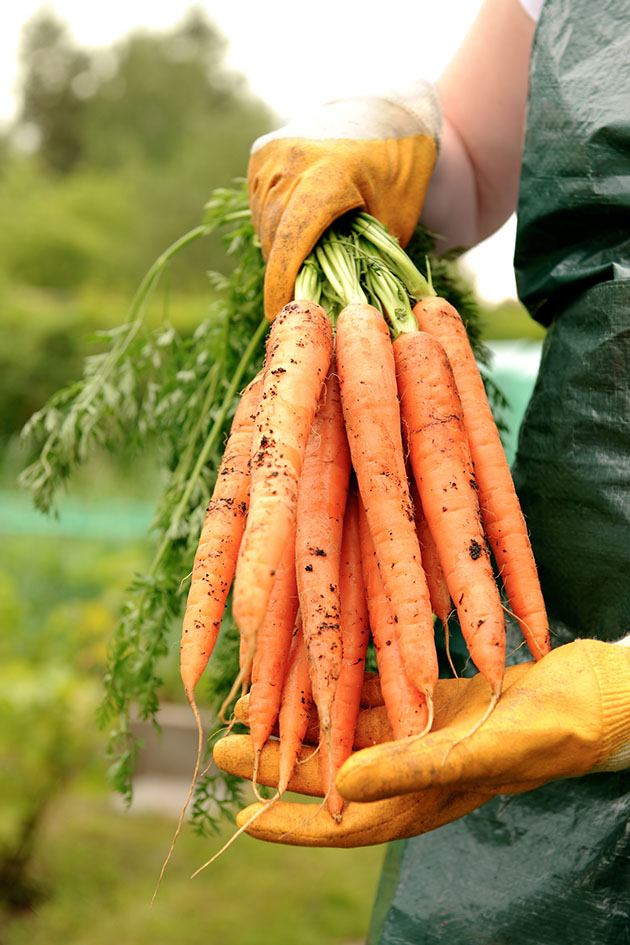
Carrots – sow one seed every inch, 1/4” deep in rows 6” apart.
Carrots might be the king of the small garden. You can plant so many of them in such a small area, they usually don’t have any pests, there are a million varieties and many different colors of carrots, and who doesn’t eat carrots?
Here is more information on planting and thinning carrots and here is my favorite thing to do with carrot tops, carrot top pesto. Also, you can freeze carrots and freeze shredded carrots for carrot cake.
Radishes – Sow 1/2” deep in 2-3” wide bands. Sow 1” apart in bands 1-2” apart.
Radish is a fast-maturing cool-weather crop. It’s great to start the season with it. I usually use radish in salads or fermented, or as a quick snack.
Turnips – Sow 3 seeds per inch, 1/4” deep in rows or bands spaced 12” apart. Thin to 1 plant every 3”. Turnip can be used like a potato (even mashed) or eaten fresh or roasted.
Parsnips – Sow a group of 3 seeds 1/2” deep every 3” in bands or rows spaced 18” apart. Parsnip is great in stews, soups, stir-fried, mashed, or roasted.
Beets – Sow one seed 1/2” deep every 3” in rows spaced 12” apart. We use beets fresh in salads (here is my favorite Israeli beet salad), fermented, or roasted.
Asian Greens to Grow in a Small Garden –
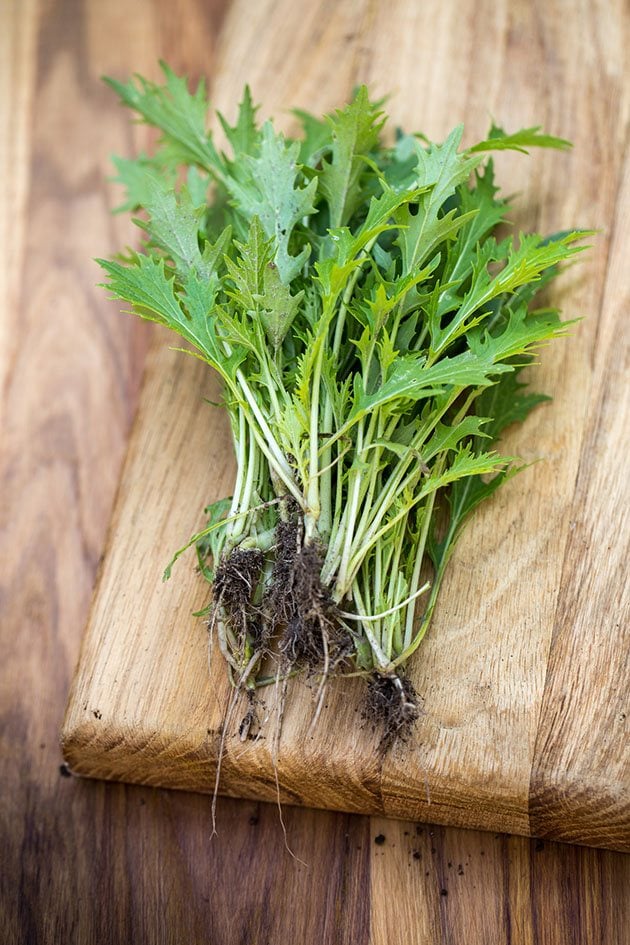
The next four Asian greens are considered a specialty crop. They can be used in soups, salads, and stir-fry. I find seeds for these at Johnny’s Selected Seeds.
Mizuna – Also called Japanese Mustard Greens or Spider Mustard. For full size, sow in 2” wide bands, 1/4” deep 1” apart. Bands should be spaced 18” apart. For baby leaves, sprinkle seeds in a 2” wide band, 1/4” deep.
Red Rain – Same as mizuna.
Shungiku – Aromatic, edible chrysanthemum greens. Same growing requirements as mizuna.
Carlton – Same as mizuna.
Onions to Plant in a Small Vegetable Garden…
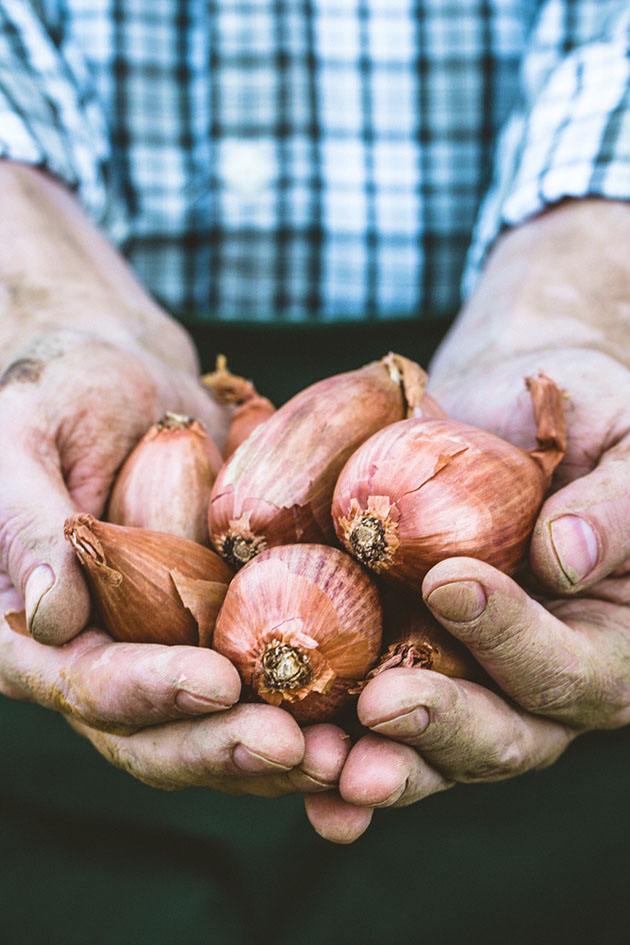
Onions – Sow in rows or bands, 2 seeds every 4”, 1/2” deep, rows or bands spaced 12-18” apart. Thin to one onion every 4” for full-size onions.
There are many varieties of onions that can be used in the kitchen in a million different ways. Onions will last a long time in storage, especially if you can find a cool place for them.
Last year I had so many onions that I ended up freezing some. I am still using my frozen onions. Hopefully, they will last us until spring.
Green Onions – Also called bunching onions. Sow in rows or 2-3” bands, 1/2” apart, 1/4” deep. Space between rows should be 12”. These onions can be added to anything from soups, salads, stir-fries, and many other dishes.
Shallots – Sow in 2-4” bands, 3/4” apart, 1/2” deep. Space rows or bands 10” apart.
You can use shallots just as you would use regular onion but you don’t need to slice them. Just add them whole (but peeled) to stews, vegetable soups, place them in your roasted chicken pan, or grill them.
Salad Greens to Grow in the Small Vegetable Garden…
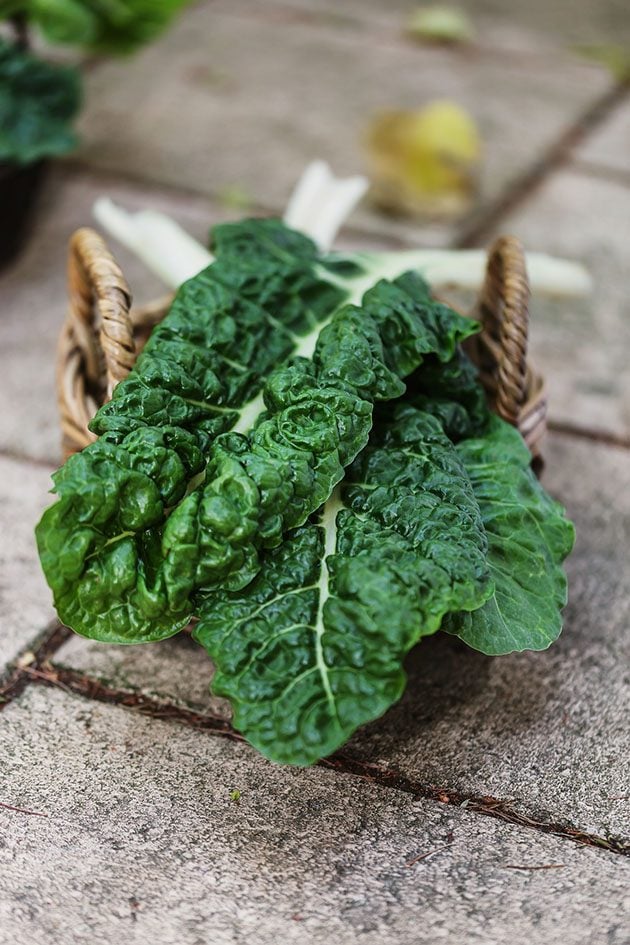
Lettuce Mesclun – Sow 1/2” apart, 1/8” deep, in rows 6” apart.
This is another must in the small vegetable garden. Where regular head lettuce needs to be spaced 8-10” apart, loose lettuce leaves can be sprinkled very close to each other. Not only that, but you can come back and cut the leaves 3 times before you have to plant new seeds. Here is more information on growing salad greens.
Mache – Sow 1” apart, 1/2” deep in rows 8” apart.
Mache is the perfect green for the Northern climates. It grows best in cold weather, in fact, seeds will go dormant at 70 degrees Fahrenheit or greater. Leaves are thick and have a nutty flavor. Great in salads or sandwiches.
Mustard – Sow one seed 1/4” deep every 2” in rows 12” apart. Thin to one mustard every 4”. Mustard is a spicy green. It adds a nice spice to salads and can be added to stir-fries or sandwiches.
Baby Spinach – Sow in 2-4” wide bands, sprinkle seeds 3/4” apart, 1/2” deep. Bands spaced 10” apart. Baby spinach is great in salads, soups, or sandwiches.
Chard – For full size, sow 1 seed, 1/2” deep every two inches in rows 18” apart. Thin to one plant every 4”. For baby chard, sow in 2-4” bands, 1” apart 1/2” deep. Don’t thin.
Chard is an easy green to grow. You can use chard in the same way you use spinach. My favorite recipe with chard or spinach is my mother-in-law’s vegetarian patties, you can find this recipe here.
And Last But Not Least…
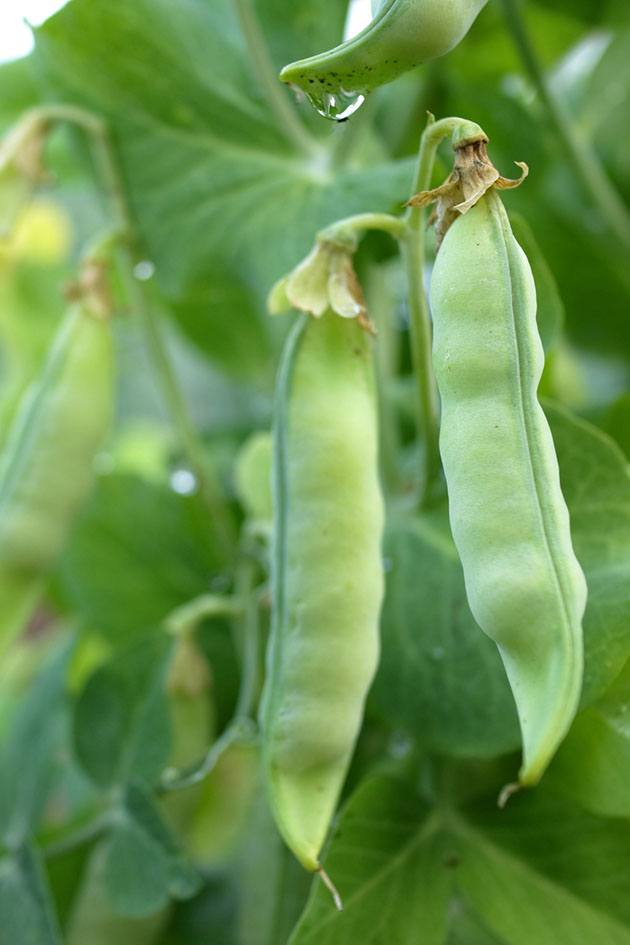
Peas – Sow in a 3” wide band, 1.5” apart, 1” deep. Space bands 12” apart.
Make sure you choose the right variety of peas for the small garden. Some varieties will need a trellis, but if you choose a variety that is under 3′ tall you don’t need to trellis it. Our favorite way of eating peas is fresh, right off the vine.
We now live in the country and I have a whole lot of room to grow vegetables. But back when we lived in town, I kept adding a couple of beds every season, however, my garden stayed a pretty small garden.
I sometimes planted the larger plants that we didn’t want to do without, like tomatoes for example, in containers. This way they didn’t take any room in the raised beds. I also tried growing potatoes and purple sweet potatoes in bins before and it worked great.
But my raised beds are usually saved for the crops above, this way I can make sure I produce as much as I can in the small space.
So, if all you have is a small vegetable garden, or if a small garden is all you can care for, there are still many vegetables you can grow. You might still choose to purchase some of your vegetables at the market, but you will also have a nice supply straight from the garden.
Till next time…
~Lady Lee~

Hi! I’m Lady Lee. I help homesteaders simplify their homesteading journey while still producing a ton of food! I am a single mother of four, I was born in Israel and raised in an agricultural commune called a Kibbutz. Now I homestead in central NC.


Thank you for illustrating seeding in bands. I’m new to gardening and reading my new seed packets and was perplexed as to how it can say to sow 1″ apart but 35 seeds per foot. So much more sense now!
Oh good. I’m happy it was helpful. I’m a visual learner myself, it’s easier for me to understand when I see things.
Most of that stuff I don’t grow the article was still helpful thank I for sharing
You are welcome!
I’m so ready for winter to be over. When it’s sunny my Nacho kitty runs out to her favorite garden spot “The Asparagus Jungle” and nothing is there. She walks back to the house looking so dejected. I still have frozen ground, can’t even start any greens yet.
I am almost ready. We actually plowed the field at the farm this week (I’ll have the post up in a couple of days) but I am not completely ready yet. We are going to visit family in Israel on the 21st this month so we are trying to finish as many things as we can so we can plant when we get back. Hang on, we are almost there!
Hi can all these vegetables grow in part shad
Most of the leafy greens can, like lettuce and spinach. But onions, carrots and other vegetables need full sun.
Awesome ideas! I’ve got 4 small raised garden beds in our yard and have to be really conscious about what I grow! Carrots and peas are two of my favorites, and my peppers always do really nicely too